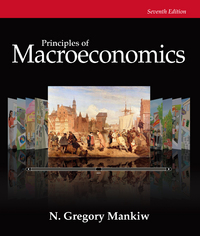Question
Assume that we have already decided to raise taxes on the very rich (it still only brings in an extra $200-$250 billion per year) but
Assume that we have already decided to raise taxes on the very rich (it still only brings in an extra $200-$250 billion per year) but we still need to do a lot more to close the gap between taxes collected and spending.
Question :
1) What do you believe is our best place to cut spending? In a short paragraph, please tell us why?
Information :
2022 U.S. Budget
Federal Tax Revenues and Spending (in billions)
Transportation : $132
Veterans Benefits : $274
Net Interest : $475
Education : $677
Medicare : $755
National Defense : $767
Social Security : $1,219
Health : $914
Income Security : $865
The Congressional Budget Office (CBO) offers a number of options that would significantly reduce the debt by 2033. CBO defines large reductions as either reducing the deficit from 2023 to 2032 by more than $300 billion or, in the case of Social Security options, have a large effect in later decades.
Of the solutions to reduce spending, the 4 key options include:
1. Changes to Medicaid. CBO addresses two solutions directed toward Medicaid reform. The first is to establish caps on federal spending for Medicaid. Almost all federal funding for the program is open-ended under current law, but if there were overall caps and per-enrollee caps on how much the federal government contributes to each state's program, the deficit over the next 10 years would be reduced by an estimated $501 billion to $871 billion.
Similarly, if federal Medicaid matching rates were reduced, it
could save the federal government $68 billion to $667 billion over the next decade depending on the extent of such a decrease.
2. Changes to Medicare.One option to reduce the deficit is to address premiums paid for physician and other outpatient services (known as Medicare Part B). Many enrollees pay about 25 percent of expected costs per enrollee, although some higher-income participants pay a higher rate. Increasing the typical contribution and freezing the income thresholds for additional contributions would reduce the deficit by $448 billion over the next 10 years. CBO also estimates that adjusting some of the benchmarks that determine pricing for the Medicare Advantage program would save $392 billion over a decade.
3. Changes to Social Security.One option CBO estimates is to set Social Security benefits to a flat amount, which would essentially change the way in which benefits are calculated.
The primary insurance amount (PIA) is a key determinant of a worker's initial benefit, and the option CBO analyzes is to make the PIA the same for all retired or disabled workers.
Because the amount would no longer
depend on past earnings, workers with high lifetime earnings would see reductions in their benefits, whereas some workers with low lifetime earnings would receive larger benefits than scheduled under current law. Setting that flat amount to 125 percent of the federal poverty guidelines would save the government an estimated $593 billion from 2023 -
2032. Another option would be to reduce Social
Security benefits for high earners. That would change the threshold at which PIA factors change, and adding a bend point at the 50th percentile of earners would lead to a reduction of $184 billion over the decade.
4. Reduce spending on other programs.Reductions for income security programs, such as the Supplemental Nutrition Assistance Program, the Supplemental Security Income program, and refundable portions of the earned income and child tax credits could amount to $327 billion over the next 10 years. Furthermore, means-testing VA disability compensation would reduce government spending by $253 billion. Another approach would trim discretionary spending. CBO estimates that reducing manpower and implementing other changes to the Department of Defense's budget would save $995 billion over the next 10 years; reductions in nondefense programs could save the government $332 billion.
Step by Step Solution
There are 3 Steps involved in it
Step: 1

Get Instant Access to Expert-Tailored Solutions
See step-by-step solutions with expert insights and AI powered tools for academic success
Step: 2

Step: 3

Ace Your Homework with AI
Get the answers you need in no time with our AI-driven, step-by-step assistance
Get Started


